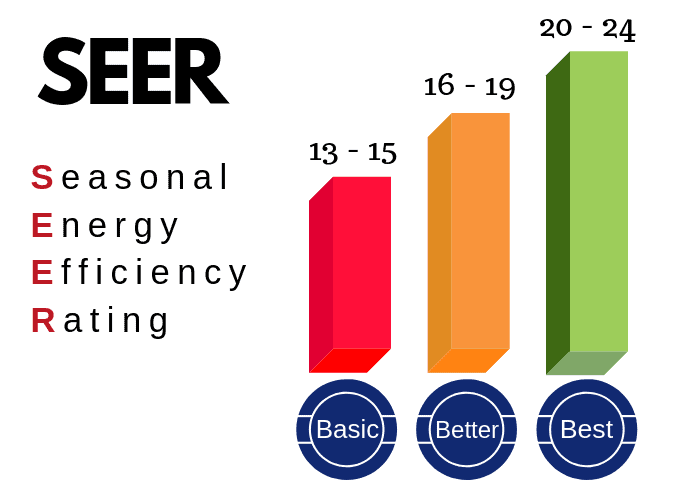When you’re shopping for a new AC for your home, one of the terms most bandied about is the SEER rating, and it is used as a selling point for a particular model. While the SEER is a useful measure of an AC’s efficiency, it is not the only factor to take into account when choosing your AC.
To help you make an informed choice when it comes to the right SEER rating for you, we’ll talk about the various factors that you should consider along with the SEER rating.

What is SEER and Who Came Up With it?
SEER is short for Seasonal Energy Efficiency Ratio and it is calculated by dividing the cooling output during a typical cooling-season by the total electric energy input during the same period. The standard was defined by the Air Conditioning, Heating, and Refrigeration Institute (AHRI) in its 2008 standard AHRI 210/240. It was known as the “Performance Rating of Unitary Air-Conditioning and Air-Source Heat Pump Equipment.” Quite a mouthful!
The higher the SEER, the less electricity your air conditioner or heat pump will need to cool your home. All air conditioners produced today must have SEER ratings of 14.5 and higher in order to earn an Energy Star rating. Ductless air conditioners and other high-efficiency systems can have SEER ratings of 25 or more. The US national requirement is SEER 13 for central air conditioners. Window units are exempt from this law, so they typically have SEERs around 10.
As of January 1, 2015, new federal regulations for cooling efficiency were put in place. These new regulations mandated higher minimum SEER ratings, with different standards for different parts of the country.
In the North region of the US, split systems need to be rated a minimum of 13 SEER, while packaged ones require 14 SEER. In the Southwest, Split ACs need to be rated a minimum of 14 SEER, and the same is required for packaged units.. In the South, both split ACs and packaged units need to be rated a minimum of 14 SEER. The differences in SEER rating minimums are due to the impacts of climate on financial returns of the energy efficiency.
Will Higher SEER Units Pay for Themselves?
Getting a higher SEER-rating AC (over 18) means it will pay for itself over time, right?
Well, not exactly.
A higher SEER-rated AC will very likely provide you with lower bills every month, but you’ll also be paying a higher upfront cost.
In fact, the expensive prices of the higher SEER ratings makes it unlikely that you’ll ever save enough money to justify the extra costs. For example, the cost to purchase and install a 21 SEER AC is $4000.

Assuming it lasts about 10 years, you may save around $1500 over that period from lower electricity bill, but still have a balance of $ $2500 left that you can never recoup.
Even factoring in state and federal rebates for energy efficient ACs, you cannot save enough money to justify selecting a higher SEER AC. So don’t fall for the tricks of a salesperson when shopping for ACs and always do the math.
To help make up your mind about whether a higher SEER rating will make financial sense, check out this calculator on Lennox’s website.
Factors that Affect What You Need
The following factors should be kept in mind when deciding what SEER rating you should look for.
Climate
If you live in a hot or warm climate, it should be a key factor in determining the usefulness of a higher SEER rating. In warmer climates, you’ll need to run your AC for longer periods, meaning that the energy efficient AC will save a significant amount of money every year.
Length of Ownership
Another factor to consider is the duration of your stay in the house where you will install the AC.
The period of your ownership and length of operation of the AC will determine how much payback you can receive.
On the other hand, the shorter your ownership period the greater your total cost will be as the purchase price will be amortized over a shorter time period. So you should only buy a higher-rated SEER AC if you intend to use it for 8 or more years. (The typical lifespan of a central air conditioning unit is 10 – 15 years.
Opportunity Cost
Think of the all the things you could do with the extra money you will spend on a higher SEER AC. That’s the concept of opportunity cost, where the opportunity value of other investments missed because of your expenditure on a product is counted.

We can take the minimum rating of SEER 13 as that is the federal minimum. So anything you buy with a rating over and above 13 will count towards the opportunity cost calculation. Where will you save more – on energy or by using that money for another purpose?
Tax Credits
You should also factor in utility, state and federal rebates and tax credits when calculating your return as these reduce your purchase price accordingly.
Other Benefits of Higher SEER Ratings
There are other benefits of higher SEER ratings besides the financial impact. So even if you think the higher cost of higher SEER ratings is not justified, the other advantages may help change your mind.
Comfort
Systems with high SEER values can remove moisture from air more effectively besides keeping the air at the desired temperature. Modulated systems help to cool the air more comfortably by running longer cycles at lower pressures. This also prevents mold and other airborne problems associated with improper moisture removal.
Environmentally friendly
Higher SEER ACs mean less emissions such as carbon dioxide and other gases because they use up less energy. They contribute to fewer greenhouse gas emissions as less fossil fuel is burned.
Highly efficient ACs utilize two-speed or variable-speed compressors to lower their speed on the compressor. This allows a 5-ton unit, for example, to draw the same energy as a 2.5 ton air conditioner.

Still Unsure? Consult a Pro
If you have a basic understanding of how SEER ratings work and have gone through the calculations of payback years and money saved but still haven’t made up you mind one way or another, it’s time to consult a reputable AC contractor.
A contractor can walk you through the steps of deciding with AC is right for you as well as sizing your AC for your needs. A trustworthy contractor will not try to upsell you on a more expensive model if you don’t require one nor propose a SEER rating that will be financially unfeasible. Perhaps most importantly, a good contractor will provide help at every step of the way, from selection to installation and after sales support.
Conclusion
As you can see, it’s not as simple as just purchasing the highest SEER AC that you can afford. Purchasing an AC is a decision that needs to take into account your climate, expected duration of use and other factors.
Do not be misled by unscrupulous salesmen; instead talk to a reputable contractor to figure out what SEER rating is right for you.
